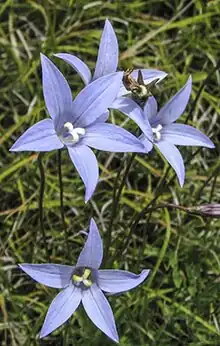| Waxy bluebell | |
|---|---|
 | |
| Scientific classification | |
| Kingdom: | Plantae |
| Clade: | Tracheophytes |
| Clade: | Angiosperms |
| Clade: | Eudicots |
| Clade: | Asterids |
| Order: | Asterales |
| Family: | Campanulaceae |
| Genus: | Wahlenbergia |
| Species: | W. ceracea |
| Binomial name | |
| Wahlenbergia ceracea | |
Wahlenbergia ceracea (from the Latin cerae = waxy),[1] commonly known as the waxy bluebell, is a small herbaceous plant in the family Campanulaceae native to eastern Australia.
The perennial herb typically grows to a height of 0.1 to 1.1 metres (0 to 4 ft). It blooms in the summer between October and February producing blue-pink-white flowers.[2] It is leafless in its upper parts, and mostly hairless with occasional sparse hairs near the base.[1]
The species is found in New South Wales, Victoria and Tasmania.
References
- 1 2 "Waxy Bluebell | Grasslands". grasslands.ecolinc.vic.edu.au. Retrieved 2019-02-01.
- ↑ "Wahlenbergia ceracea Lothian". PlantNET. Royal Botanic Garden, Sydney. Retrieved 3 August 2017.
This article is issued from Wikipedia. The text is licensed under Creative Commons - Attribution - Sharealike. Additional terms may apply for the media files.